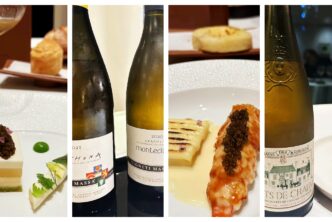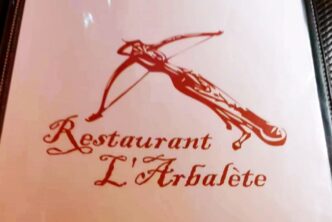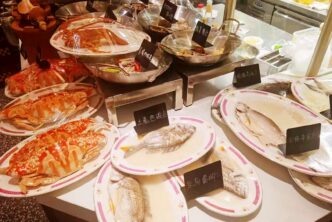Many of my New York City friends consider Le Bernardin the best restaurant in that city. The Michelin Guide, the world’s most prestigious food arbitrator, certainly ranks it highly, having given it three stars, their top award, annually since 2005. To put that in perspective, New York City today has only four Michelin three-star restaurants and no other U.S. restaurant has had three Michelin stars for that long.
A bit of history. In the 1970s, brother and sister Gilbert and Maguy Le Coze, opened Le Bernardin with its stunning seafood-oriented menu across from the famed Tour d’Argent in Paris’ 5th arrondissement. It was wildly successful in Paris, earning a Michelin star in 1977 and a second star in 1982, which it held until it moved to New York in 1986. After the untimely death of Gilbert in 1994, Eric Ripert, who had been chef poissonier (fish chef) at Joël Robuchon’s Michelin 3-star restaurant in Paris, Jasmin—so he knew a thing or two about cooking fish—took the reins in the kitchen and eventually became co-owner with Maguy. He remains at the helm in the kitchen turning out extraordinary seafood ever since.
So, the question is, how good is it and does it still deserve the accolades. And of course, is it worth it? With some effort, but mostly luck, I managed to snare a reservation for three for dinner on a Monday night.
The warm welcome and gorgeous setting soothes immediately. Hectic noisy Midtown Manhattan becomes a distant memory as you enter an elegant, quiet room. Nicely spaced and artfully set tables, beautiful flowers, and a life-sized mural of the sea makes you feel like you’re at the Mediterranean.
We opted for the four-course $210 dinner menu. The seafood-focused menu is divided into almost raw, barely touched, and lightly cooked. Diners select any two from the 11-options listed under raw and 10 options from the barely touched selection, and then one from the nine choices from the lightly cooked section. A separate dessert menu appears later. There is also an enticing eight-course $325 tasting menu ($495 with wine pairings) for the entire table.
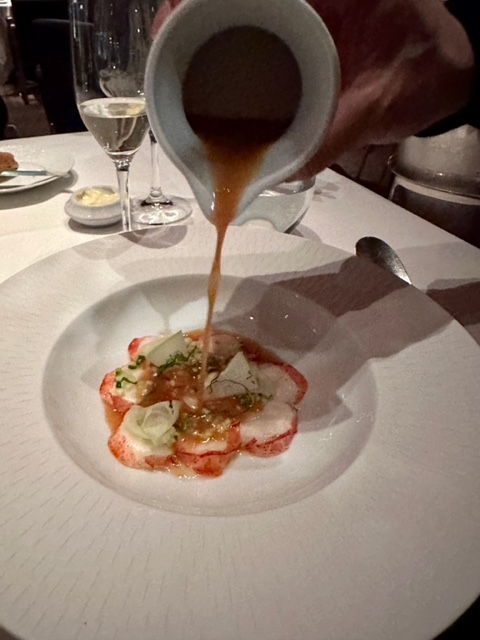
Of course, the meal started with a trio of delectable amuse-bouche that predicted that great enjoyment was to follow. We were not disappointed. Ripert seamlessly integrates flavors from around the world in his imaginative, yet not overdone cuisine. Like great wine, everything that comes to the table is balanced and harmonious. The flavors work together. The food on the plates speaks and holds your attention without shouting. No flamboyance here, just precision without being precious.
Surprisingly, the only pain of the evening appears soon after the menu arrives. How to choose from the tantalizing options in the almost raw category? Do you want thinly pounded tuna and foie gras? Yes. Or tuna and sea urchin? Yes. Or scallop carpaccio with a yuzu ginger broth. Yes, again. We opted for those three. All were superb and vastly different—the tuna foie gras was rich and silky while topping tuna tartare with sea urchin lent a more savory and briny profile to the dish. The ying/yang of ginger and yuzu bathing succulent slices of scallop offset the mollusks’ sweetness.
The quandary continued trying to select from the barely touched selection. It would have been criminal to pass on the warm lobster carpaccio swimming in its subtle Thai curry-lemongrass bouillon. And do you really want to ignore the heavenly combination of seared langoustine and offset by small morsels of foie gras nestled in a tiny cabbage leaf? And how to pass on the surf-turf theme of charred melt-in-your-mouth octopus in a smoky chorizo mousseline? The waiter, sensing the dilemma, offered a brilliant and sensible solution—just add an extra plate. We opted for the Japanese madai, a fish none of us knew. We are now thrilled to have been introduced to this firm and fleshy specimen enhanced but not overwhelmed by the fennel-olive-citrus sauce. Problem solved. It was the epitome of service—everything appeared seamlessly without a trace of obsequiousness.
Although not as lengthy, the lightly cooked category still presented us with difficult choices. Thankfully, we managed! The crispy black bass swimming in a light lemon-smoky pimentón sauce exploded in the mouth and showed the world-wide range of Chef Ripert’s talents. Grilled hiramasa, another unknown-to-us Japanese meaty fish, stood up effortlessly to the roasted maitake mushrooms and a luscious bone marrow red wine sauce. Though we happily consumed the last of our 2020 Benjamin Leroux Bourgogne Aligoté with it, a red wine would have been equally satisfying with this fish masquerading as veal. I’d happily meet hiramasa again! The pan-seared fluke floating in a delicate urchin-bouillabaisse emulsion finished the Mediterranean theme.
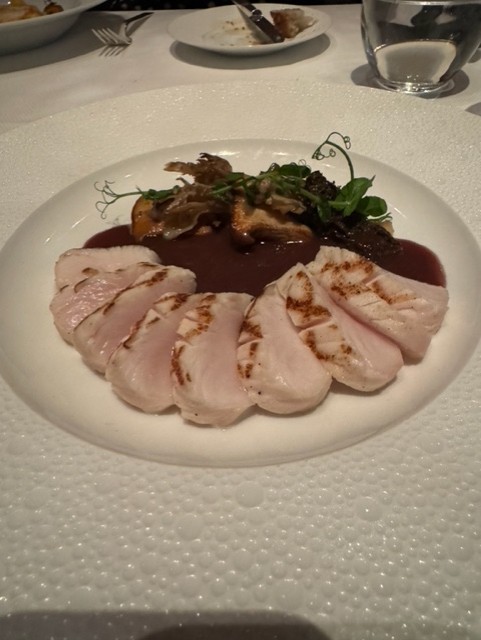
While there are the trophy wines, whose prices contain five digits, on the list, Aldo Sohm, the head sommelier and his team, has assembled a thoughtful and diverse list, with something for everyone. Maxime Blaise, one of Le Bernardin’s eight sommeliers, guided us through with grace keeping within our budget. In retrospect, we foolishly started with a half- bottle ($80) of a stunningly elegant NV Diebot-Vallois Blanc de Blancs Extra Brut. Non-vintage Blanc de Blancs Champagne are not common, so I leaped at the opportunity. Simultaneously elegant and persistent, the first sip confirmed the mistake of ordering a half-bottle. Ordering another one easily corrected this misstep. The Diebot-Vallois reinforced just how versatile Champagne is with food, cutting through the myriad of flavors on the table and refreshing the palate after every bite. Continuing the theme that high acid wines complement everything on the plate, we opted for the aforementioned 2020 Benjamin Leroux Bourgogne Aligoté ($90). The ripeness from the vintage coupled with the acidity of the Aligoté and the talent of Benjamin Leroux made this a masterful choice with everything from the warm lobster carpaccio to the charred octopus.
In keeping with the French sensibilities, the deserts were superb and not overly sweet: an exotic fruit (roasted pineapple, guava jam, yuzu-coconut sorbet) Pavlova, a rich but not heavy Peruvian chocolate torte topped with explosively favored spiced chocolate ice crem, and a yummy bevy of in-house made ice creams and sorbets.
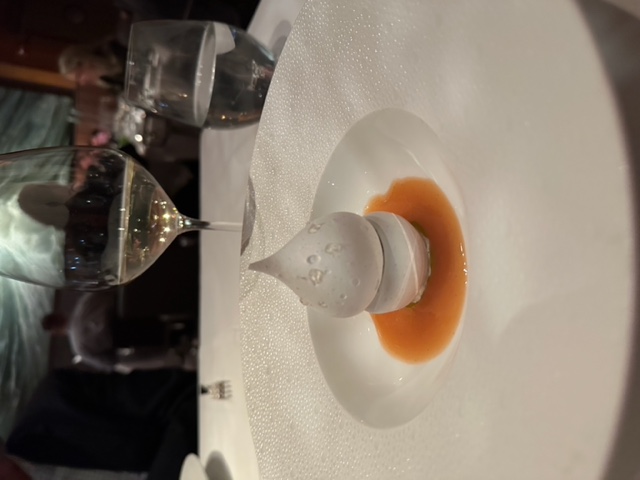
The answer: Le Bernardin remains an extraordinary restaurant, among the top in the world, deserving of all the accolades it continues to amass. The food, the service, the setting is simply dazzling. The price, including wine and the extra “barely touched” selection, but not the tip, is not for the faint of heart–$1,029 for the three of us, or roughly $350 per person. I generally don’t tip 25 percent, but at Le Bernardin the attentive but not overbearing service deserves it. So, adding a 25 percent tip brings it to about $425 per person. Was it worth it? We’d return in a heartbeat.

 中文
中文
